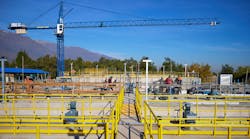Southern California faces two key challenges concerning its storm water and water quality management. One is reducing the amount of rainfall that becomes polluted runoff and enters storm drains, streams and oceans. The other is maximizing the amount of storm water that is recharged into local aquifers to offset the large quantities of water that are pumped out by local purveyors.
LA Sanitation – City of Los Angeles partnered with North East Trees, a community-based nonprofit organization, to tackle these challenges with the Garvanza Park Rainwater Capture and Use Project, funded by grants from the city of Los Angeles and the Regional Water Quality Control Board’s Propositions 13 and 40. This project was the recipient of the California Stormwater Quality Assn.’s 2012 Outstanding Best Management Practice (BMP) Implementation Project Award.
Garvanza Park is a public park located in Highland Park in northeast Los Angeles near the Pasadena border. A 48-in. reinforced concrete storm drain pipe passes under the park, carrying all of the water draining from a hilly neighborhood to the Arroyo Seco, a tributary of the Los Angeles River. Typically, this urban storm water runoff, carrying oil and other pollutants of concern that have accumulated on the watershed’s impervious surfaces, travels to the Los Angeles River and reaches the Pacific Ocean near Long Beach.
Compliance & Conservation
According to Vik Bapna, principal of the lead design firm, CWE Corp., the intended functions of the Garvanza Park Rainwater Capture and Use Project are to “enhance the water quality of the Arroyo Seco and Los Angeles River and comply with metals, trash and bacteria total maximum daily loads (TMDLs), provide water conservation benefits including groundwater recharge, reduce the use of potable water and serve as a successful model of a regional BMP project for broad application throughout the Los Angeles region.”
The project intercepts storm water from the existing storm drain and diverts it through a modified offline continuous deflective separation (CDS) pretreatment system that uses a combination of swirl concentration and indirect screening to filter, separate and trap debris, sediment and oil from the storm water runoff. The CDS pretreatment system is efficient and capable of capturing and retaining 100% of floatables. After the storm water is pretreated, it enters a sedimentation basin designed to remove the smaller particles that bypass the CDS system. From the sedimentation basin, the runoff travels to an adjacent retention basin, where a portion is used to irrigate the park’s vegetation during dry months.
This water is further treated by the subsurface irrigation system’s disc filter unit. After the retention basin, additional storm water runoff is retained in an infiltration gallery, where it percolates through the soil into the groundwater table.
The project utilizes various innovative techniques and technologies that contribute to important advancements in the storm water management and construction communities. Take, for example, the project’s multiuse benefits. Rather than simply diverting polluted storm water away from the impaired Arroyo Seco, more than 1 million gal of water are collected per 3/4-in. storm event in underground chambers beneath Garvanza Park’s surface. Then, 440,000 gal are detained for infiltration and groundwater recharge, while 600,000 gal are stored to irrigate the park during the dry season—a unique and innovative approach to sustainability which reduces the use of potable water for irrigation.
The remaining 600,000 gal undergo pollutant particle sizing reduction using settlement. The BMP system has zero discharge to the receiving water and removes any remaining pollutants of concern while providing water conservation benefits. Sensors are used to automatically and immediately bypass the system should gross pollutants be detected to keep them from entering the groundwater.
In order to maximize the use of storm water to irrigate the park during the dry season, a Netafim subsurface irrigation system was installed. The system provides numerous benefits, including eliminating water waste caused by surface evaporation, delivering water directly to the root zone of the park’s grass and trees, and reducing maintenance needs in comparison to sprinkler systems. In addition, water-hungry turf grass was replaced by a drought-tolerant buffalo grass for additional water conservation.
Results Apparent
A study was conducted by the LA Sanitation Watershed Protection Div. to evaluate the function and effectiveness of the Garvanza Park BMPs. Based on monitoring, water sampling, laboratory analysis and pollutant load reduction calculation results, it concluded that the Garvanza Park project is showing tangible progress in terms of TMDL compliance, as well as providing a means of capturing and using storm water runoff for subsurface irrigation, thus reducing the park’s water demand.
The project has proven to effectively divert 100% of dry weather (urban) runoff, and approximately 95% of storm water runoff. The estimated annual pollutant load reduction for this project is 90%. If the project continues to be maintained and optimized for capturing runoff (especially during storm conditions), significant reductions in pollutant loads will be accomplished by this treatment system.
It is hard to overemphasize the importance of water conservation as Southern California continues to experience long-term drought conditions and decreasing water supplies. Instead of treating storm water runoff as waste, the Garvanza Park project captures it and uses it as a valuable resource.
The project represents Los Angeles Mayor Antonio Villaraigosa’s agenda to make the city a national model of sustainability and green growth. It incorporates multiuse benefits to fulfill the original project objectives, while addressing additional environmental concerns at a minimal cost. The Garvanza Park project is a successful model of a regional BMP project based on its incorporation of multiuse benefits, effectiveness in improving water quality, and the statement it makes about the city of Los Angeles’ movement toward sustainable water management and preventing polluted runoff from entering storm drains, streams and oceans.
Download: Here


